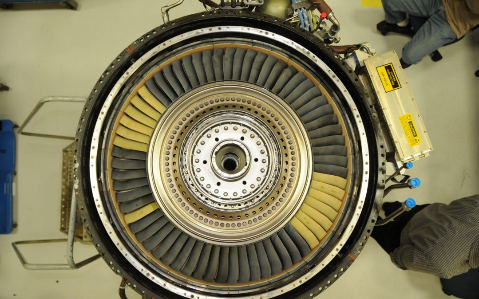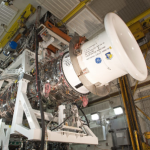Renowned for their prowess in commercial engines, Ceramic Matrix Composites are accelerating the future of military propulsion as well.
Tomorrow’s military missions will demand engines that provide a 25% reduction in fuel consumption resulting in more than 30% greater range, while delivering up to 20% more thrust. Running engines at hotter temperatures and higher pressures is required to meet those aggressive goals, but the temperatures of state-of-the-art super alloys have been pushed to the absolute limit.
“Ceramic Matrix Composites, or CMCs, are helping us solve the fuel efficiency riddle for our next-generation Advanced Fighter engines,” said Mike Eisenmenger, Manager of the Adaptive Engine Transition Program.
Engines powering today’s military aircraft are limited, or “fixed,” to either maximum power or fuel efficiency, which limits aircraft performance and increases operating costs. GE is developing an Adaptive Cycle Engine that differs from fixed cycle engines in its ability to instantaneously alter from a fuel-efficient engine—similar those deployed on commercial aircraft—to high-performance engine needed for fighter jets.
“By using lighter-weight CMCs and reducing the amount of cooling air required to run the engine, we can answer the call for improved thrust, fuel efficiency and range,” said Mike Eisenmenger.
In 2015, GE achieved an industry first by successfully running a rotating CMC part in an F414 engine. The test mimicked the operating features the new Adaptive Cycle Engine design will encounter. Last year, GE replicated the feat by using more advanced CMCs in a “flight-weight” design to further verify their robustness.
CMC testing put a punctuation point on a busy 2016 Advanced fighter engine testing calendar that culminated in a new centerline High Pressure Compressor test in September. These efforts paved the way for 2017 core testing (combustor, compressor and high pressure turbine) —otherwise known as “the heart of the engine.”
“Validating the applicability of CMCs and advanced components ahead of schedule and in a true operating environment means risk reduction for the technical program at less cost, and truly helps us unlock the potential for next generation mission capability,” said Mike Eisenmenger.
GE Aviation building U.S. blueprint to industrialize CMCs
GE Aviation is on the final phase to create its most vertically integrated, new material system ever introduced in the United States.
By 2020, GE Aviation is projected to have more than 750 U.S. employees dedicated to its CMC industry.
In just 10 years, GE Aviation has spent more than $1.5 billion to bring advanced CMC technology to market. Beyond GE’s Global Research Center in Niskayuna (NY), this investment includes four production facilities in Evendale (OH), Newark (DE), Asheville (NC) and a full-rate production raw material facility in Huntsville (AL). Once fully operational, Huntsville will produce up to 20 metric tons (20,000 KG) of CMC material a year. One CFM LEAP engine uses approximately 1 KG of CMC material.
GE Aviation is investing more than $200 million to construct two factories on 100 acres in Huntsville. One plant will mass produce silicon carbide (SiC) ceramic fiber, the first high volume production operation in the United States. Supported by funding ($21.9 million) from the U.S. Air Force Research Lab Title III Office, this plant will dramatically increase U.S. capability to produce SiC ceramic fiber capable of withstanding temperatures of 2400F.













